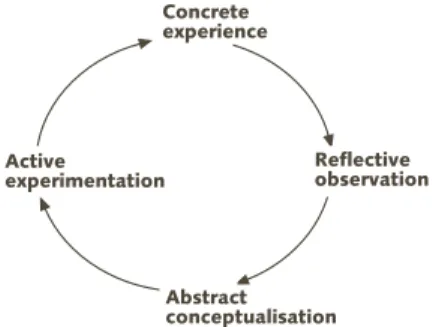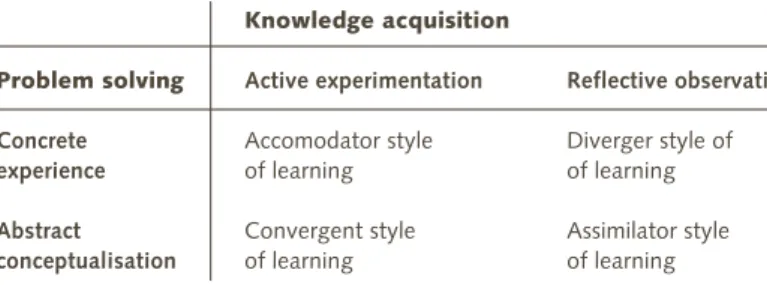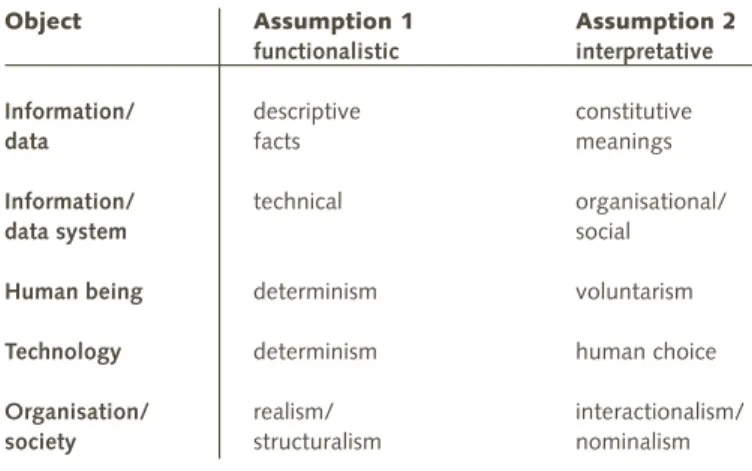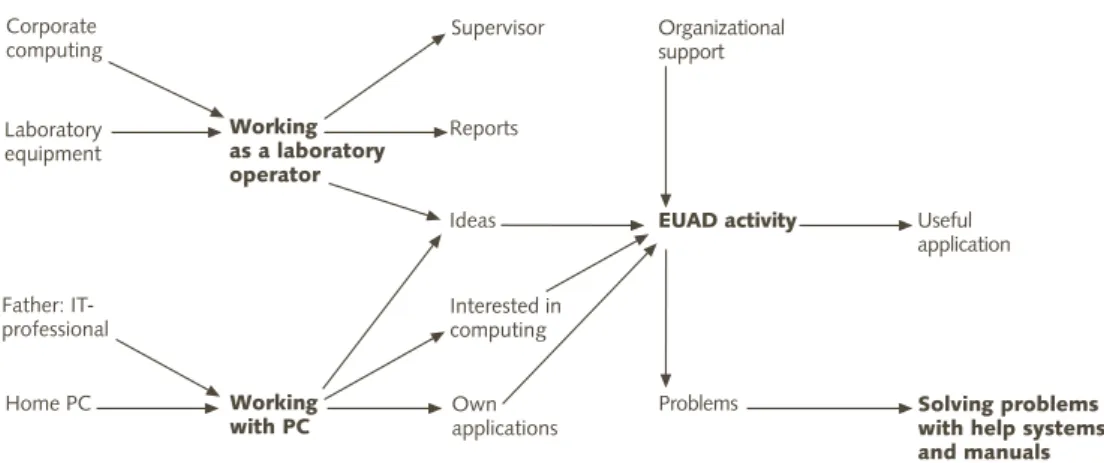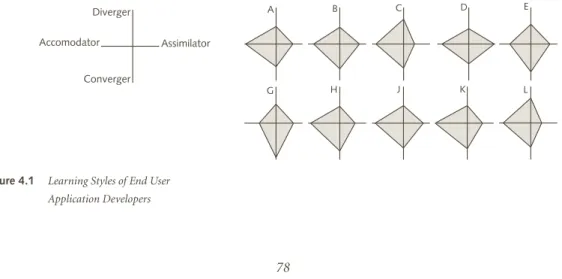At the end of the study, we analyze the organizational implications of the EUAD activity. There will always be some contradiction between the different 'life worlds' of the people working in the organisation.
Basic Concepts
- End-user (EU)
- End-user Application (EUA)
- End-user Application Development (EUAD)
- Creativity and Innovation
- Motivation
- Learning and Learning-intensive Technology
- Personal Learning Styles
The learning process around the development of end-user applications comprises two subjects (Figure 2.1): the organizational task to be performed and the technology in the form of the tool used. The instrument participates in the learning process in three different roles:. i) the tool used in the organizational task (Tool A), (ii) the tool needed in learning the organizational task (Tool C), and finally (iii) the end user needs a software tool as an instrument (Tool B) to develop an application (Tool A) for the organizational task.

Research Goals and Questions
Finally, the third research question attempts to discover the consequences of the ROAD activity. From the first question (FUQ 1.1) we want to get more information about the informant's motivation.
Research Approach
Paradigmatic Assumptions
- The Philosophical Assumptions about the Organisation
- Formal and Social Organisation
- The Assumptions of Information Systems
- The Philosophical Assumptions of the Study
We also accept the radical humanist paradigm's view of the changing nature of society. For example, the manuals in the technician's work do not always meet the requirements for the actual work in practice.

Empirical Study
- About the Sample
- The Implementation of the Interviews
- The Questions of the First Interview
- The Questions of the Follow-up Interview
This question is expected to address one of the most important phases of the informant in relation to EUAD activity. The answers to this question also provide information to analyze the consequences of EUAD activity for EUADers.
Methods to Interpret the Data
In the figure above (2.4), the informant cited the fact that his father was an IT expert and they had a personal computer at home as reasons for his work with a personal computer. In this chapter, we review the data and each of the interviewed persons.
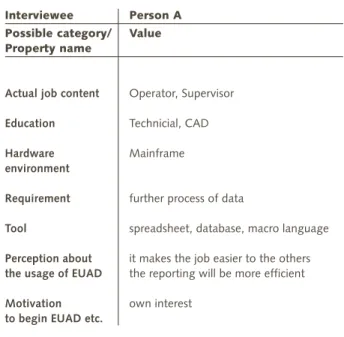
About the Subjects
We briefly describe their work environment and the content of their own work during the first interview. This includes personal reasons for starting application development, as well as the consequences of this activity for their work content, self-perception as a worker and plans for the future.
The Stories of the Interviewees
34;We need a structured system that is controlled by the state, like the one we have in the movie archives.". 34;This computer salesman said that it's the IT department that decides what people use...the hardware is just brought in and the man starts working with it. 34;This is my personal opinion that these computing tasks should always be done with a certain playfulness.".
The idea of starting my own business had actually been in my mind for five years.". 34;…if I wanted to do something more challenging than working in a warehouse, I'd have to find software to create or another problem to solve, but that kind of problem wasn't at hand.".
Personal Profile of EUADers
- Personal History of Computer Experience
- Self-efficacy, Commitment and Attitudes
- Future career plans
- Learning Styles
The final state of the EUAD is realized by the consequences in the career and work content of the EUADer. Finally, we analyze the consequences of the EUAD activity for the professional careers in Section 4.4. In the case of the EUAD, commitment refers to the person's willingness to use and sustain the use of computers in his or her work.
The commitment focused on using computers was measured by looking at the level of the EUAD activity. When asked about their perceptions about the future, many of the persons (C, G, H and J) were more likely to talk about the future of their own job content.
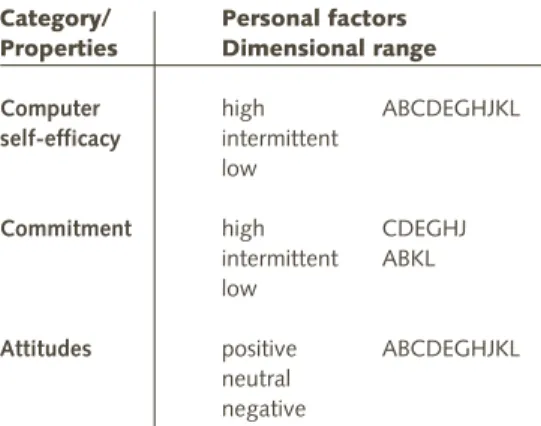
Actual Work Contents
The interviewees were not very good at getting a holistic view of the system being developed. Six of the informants work in an industrial setting, two in the public service sector and two in research or education. A summary of the characteristics of the interviewee's work is shown in Table 4.4 on the next page.
On the other hand, the persons may also be dependent on the organizational information systems. This fact is evident, among other things, from their realistic opinions about the role of the EUAD.
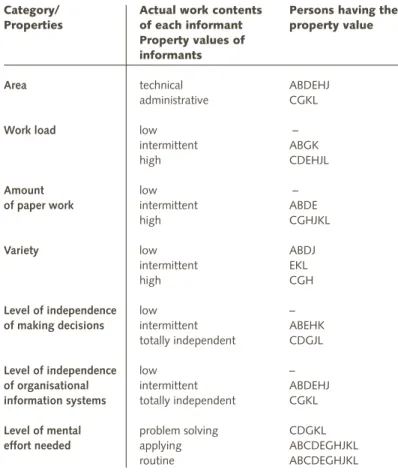
Description of the EUAD Process
- Applications, Tools and Methods
- Types of Applications
- Tools and Methods
- Development Intensity and Motivation Structure
- Patterns of Adoption
- Patterns of Adoption and Tools
- The Role of EUAD for the Worker
Some of the applications (B and K) are developed for own use and some (C,D,G and J) for others. Eight of the people linked their activity to external motivations such as usefulness in their work (C, F, K and L). The second group of EUADers covers the people who develop applications for use by others (C, D, H and J).
For some informants, the EUAD activity seems to be more important and in a different way than for others. We found four different types of EUADers, depending on the role that the EUAD activity plays in EUADers' work.

Consequences of EUAD
The Short Term Changes on Work Content
One of the obvious changes in work content after starting the EUAD activity was the ease of paperwork. In many cases, when EUAD activity was noticed, the individuals had given more tasks in that area. The effect on the work content differs per person, depending on the application area of the developed systems.
Those who developed applications for their own use (A, B, E, H, K and L) could also improve and enrich their actual work.
The Long Term Effects on Work Career
- The Work Careers of the EUADers
- Reasons for Seeking IT Job
- Power Plays of the EUADers
According to the first interview, most informants who switched jobs to an IT profession did not initially aspire to do so. We can also look at professional careers in light of the role the EUAD activity plays in the person's work. The EUAD activity of some EUADers also sparked discussion and also led to conflict.
The case with person C was different in that he did not change jobs. The immediate effect of the EUAD can be seen both in the work content and status.
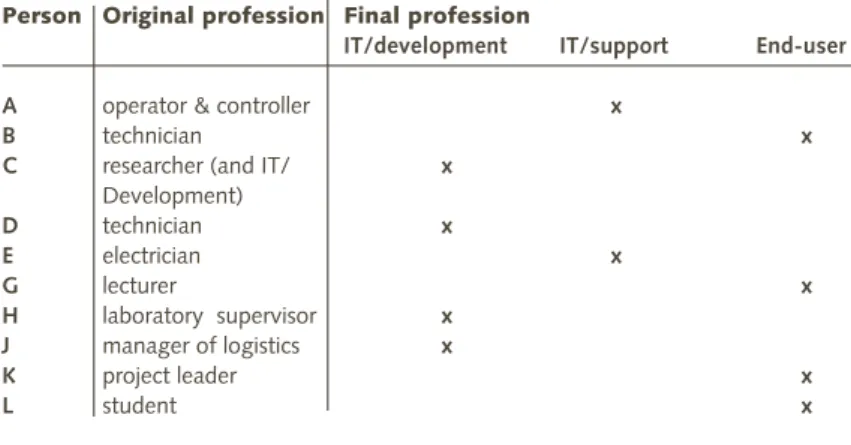
Summary of Data Analysis
To summarize the results of this subsection, we can say that the EUAD activity has both immediate and long-term effects. They are mostly driven by intrinsic motivation, which makes them look for new areas to apply EUAD. Regardless of the pattern used, they all consider the EUAD activity interesting and useful.
Finally, in the third research question, we also describe the consequences of the EUAD for their work and professional career. In section 5.3 we summarize how the EUAD has influenced the work content and further career of the end user.
EUADers as Application Developers
The informants' CSE and engagement also reflect a positive attitude towards computer technology, the job and the organization as a whole. The positive attitudes towards computers reflect the nature of the EUAD activity as a user involvement in the application development process. The reason for this may be the different role of the application development activity: the EUADs practice their activity as an additional, innovative activity in their work, which is not organized by the management.
The work mainly consisted of controlling and reporting the company's production and financial functions. The application types from the EUADs reflect their work content, which includes tasks of planning and analysis that require problem-solving independence for individual decision-making.
Motivation Structures and Categories of EUADers
Earlier Studies about Computer Acceptance
According to Rogers, the decision to adopt is mainly based on the knowledge about the technology in case. The Technology Acceptance Model (TAM) (Davis 1986) resembles Rogers' process of adoption in its basic structure. The actor is expected to purposefully and rationally evaluate the advantages and disadvantages of the technology in each case.
34;mean-end oriented" outsider, even if he or she is seen as the end user of the technology. In the case of adoption, as shown above, end users tend not to be very eager to cite organizational factors, personal characteristics, or internal motivations as reasons for using the technology.

Our Findings about Motivational Factors
There are three basic motivational factors that form the basis of the EUAD activity of end users. Our findings complete those few studies that highlight the intrinsic motivation of the most innovative people in technology adoption in the field of the EUAD. Which one of the factors, the intrinsic or extrinsic comes first, remains as a "chicken.
For many of the EUADers in our study, the reason for starting the EUAD activity was based on personal characteristics. The concept of affect/anxiety from the SCT is related to our concept of intrinsic motivation.
Categories of EUADers
The question of tools can be interpreted in light of the intentions of the actions made by the end user. The role of the EUAD works differently with persons in relation to their status in the working community. The persons in our study did not (yet) work in a management capacity in areas of the 'complex analysis of data'.
None of the previous studies have emphasized personal motivation as we did in our study. We tried to find out the intentions of the end user and what he or she is aiming for.
Consequences of EUAD
Implications on Work Content and Career
Organisational Implications
- EUADers as Change Agents
- EUADers as Knowledge Creators
- EUAD and Core Capabilities
- EUAD and Job Design
- Conclusions
According to Nonaka (see Figure 5-4), all knowledge originates originally in the minds of individuals. How does the EUAD activity contribute to the organizational knowledge creation in the light of organizational learning. According to the modern resource-based view (RBVF) of business, it is the knowledge that is the essence of companies that make them different market participants.
In the case of EUAD, the user has to take the risk of investing his time. Knowledge is mainly in the minds of employees and in the daily practices of group behavior.

Assessment of Validity and Reliability of the Study
Three of the principles are directed at the researcher and five at the research itself. Cummesson aims three of the criteria at the researcher and five at the research itself. The first criterion for the researcher (criterion 2) concerns the presentation of the paradigm and pre-understanding.
This is considered problematic because of the human component in the data collection. However, the problem is not that big because of the research topic of the study.
Limitations of the Study
Introduction to End-User Computing: Concepts, Issues, and Applications, John Wiley & Sons, New York, p. 1994), Metodo in medvetande, Acta Universitatis Gothoburgensis, Gothenburg. Information System, Journal of Information Technology, no. 13, p. 1994), Quality issues for end-user software, Journal of Systems. Concepts, Issues, and Applications, John Wiley & Sons, New York, p. 1975), Intrinsic Motivation, Plenum Press, New York.
Evolutionary Change, Journal of Business Research 41, No 1, pp.15-27 Järvinen A. 2001), Modeling Reflective and Contextual Learning at Work,. Readings in the Management of Innovation, Boston: Pitman, pp. 2000), Understanding Human Competence at Work: An Interpretative.
Recommendations to Practitioners and Researchers
